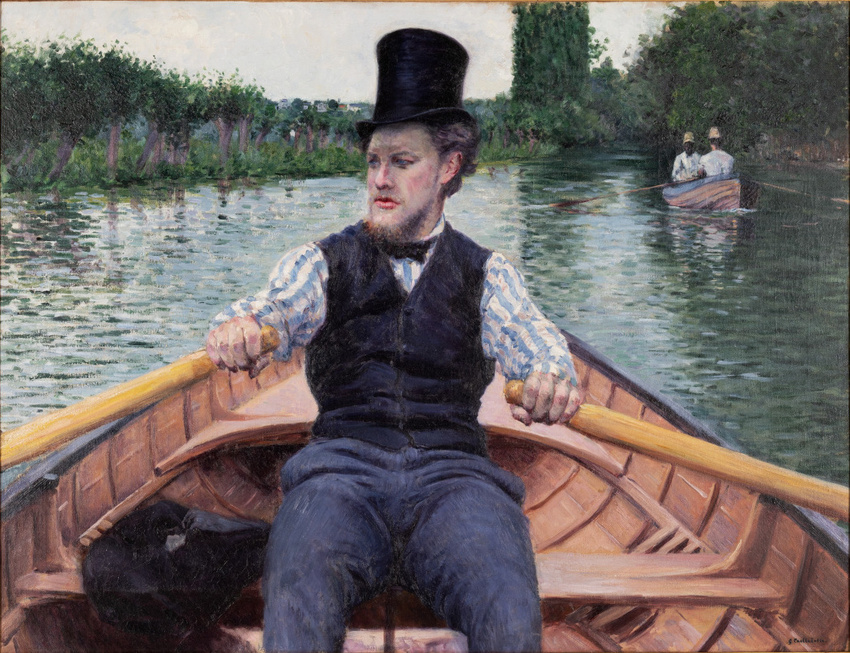In an article published last year, Jim van Buskirk commented on the apparent avoidance of discussion around themes of homosexuality and homoeroticism in the work of the French Impressionist painter Gustave Caillebotte (1848-1894), by authors of books and exhibition catalogues on the artist. Mostly active in the 1870s and 1880s, Caillebotte stands apart from the other Impressionists for being the one artist to frequently depict men, and often in ambiguous scenes where one is never entirely sure of the artist’s intention or the viewpoint of the male figures within. One only has to search on social media sites such as Twitter or Tumblr to find a plethora of homosexual references to the painter, and blog posts such as recent ones by Zimra Chickering and Bryn Donovan which question the sexuality and intentions of the artist. Although rarely discussed in academia, if ever, the ‘gay gaze’ as van Buskirk calls it, is the aspect which underpins many of the paintings which feature men in Caillebotte’s work. Paintings which contain elements, sometimes covert in nature, that create an appeal to a homosexual audience but may be missed by the heterosexual viewer.
One of the works mentioned by van Buskirk is the Boating Party of 1877-78 (above), also known as Oarsman in a Top Hat. It is a new acquisition of the Musée d’Orsay in Paris which went on display in January 2023 after being in a private collection. Thus, there’s renewed interest in the painting and a new record of the work which appears on the museum’s website. They describe it as an ‘example of Caillebotte’s desire to produce something truly modern’, and continue with, ‘the painter offers an original ‘immersive’ framing which places the viewer in the boat and seeks to abolish the distance between the space of the painting and that of the viewer’. In this image, we are presented with the scene of a well-dressed male as the rower. The activity here is presumably a leisure one, strenuous enough for the removal of his jacket laid by his side, but not enough for removing the top hat, which in turn acts as a reminder to the class status of the figure. The spectator is permitted to experience a direct and uninterrupted view of the rower’s crotch, which is simply unavoidable. And framed almost centrally. Whilst free to look and enjoy a full view of the rower, the rower’s gaze is averted, therefore avoiding any complication. As pointed out by van Buskirk, the direction of the spectator’s gaze towards the crotch is never highlighted in academic material, or indeed on the museum’s website.
An example of this can be found in the Paris and Chicago exhibition catalogue from 1995, when Anne Distel confirms how the painting adheres to a Caillebotte compositional trademark of exaggerated foreground and deep perspective, stating it is only the rower’s feet which prevent the artist from getting any closer, and then continues to describe how detailed the strong hands are in the work which provide an indication of the rower’s physical strength. In a very heteronormative reading on physicality and an artist’s eagerness for the viewer to be amidst the action, Distel bypasses the noticeable characteristic of the work. The close proximity of the rower also encourages the viewer to become the companion within the scene, which only heightens the sense of intimacy. The homoeroticism of the painting is therefore subtle, but it is there, and it is indeed surprising that it’s omitted from academic discussion. The rower may not appear heroic or statuesque, and there is no revealing of flesh – Caillebotte frequently created series of paintings and some of his other oarsmen reveal strong arms under short-sleeve shirts – but while the original critique focusses on its modernity in framing and perspective, it does create a desire to ‘look’ for a homosexual audience. Instances such as this are typical of the secondary, homoerotic readings which are apparent to the viewer but omitted from academia in a number of Caillebotte’s works.
It must be stressed that we don’t know if Caillebotte intended for these readings to exist, nor do we know of his sexual preferences, which is likely the main reason scholars have for the most part shied away from speculation. He also created many other works including landscapes and still lifes which obviously just can’t be considered in the same way. This perhaps adds to the ambiguity and covert nature of those images which do appeal to the gay gaze, and ultimately, these readings exist to a modern audience regardless of the original intentions. Even more interesting though is the fact that for most of 2023, Boating Party was hung opposite another of Caillebotte’s major works to feature men, The Floor Scrapers of 1875 (the subject of another blog post to follow soon). I really wonder how many visitors to the Musée d’Orsay noticed the apparent homoeroticism when stood in between these two paintings which were only metres apart? Boating Party is currently touring France, at museums in Lyon, Marseilles and Nantes until August 2024 when it returns to Paris to appear in a new temporary exhibition, one which will explore the masculinity in Caillebotte’s work. We will find out then if academia is ready to accept the homosexual elements within these images…
Sources
Distel, A. (1995). Gustave Caillebotte: Urban Impressionist. Chicago: The Art Institute of Chicago.
Van Buskirk, J. (2023). Straightwashing Gustave Caillebotte. The Gay and Lesbian Review Worldwide.
